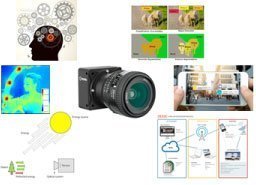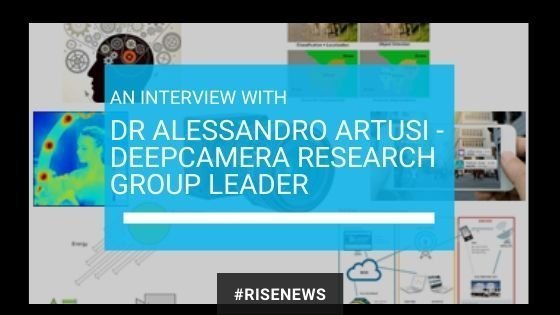Dr Artusi holds a Ph.D. degree from the Vienna University of Technology, in Computer Graphics, and a MSc. degree in Computer Science from the University of Milano (Italy). Dr Artusi joined RISE as the DeepCamera MRG Leader in July, 2019.
His main research activities are in the areas of Image processing, Computer Graphics and Color Science. He has long standing activities in High Dynamic Range technology, image/video encoding and its standardization, Image content retargeting, energy saving algorithmic solution and image/video subjective and objective evaluation. He has recently initiated deep-learning investigation activities to be applied to typical image processing and computer vision problems and has shared with us some valuable information regarding the current and future plans of his research group.

RISE has given me the opportunity to freely define and develop the research goals of my group, while allowing me to drive different types of academic and industrial collaborations.
1. Dr Artusi, why did you become a scientist? What drew you to this field and consequently your area of research at RISE?
I realized my passion for Computer Science from a very young age. I had my first Commodore 64 at the age of fourteen and I used it for simulating simple physics experiments – at the time I was programming using BASIC and some Assembly languages. By the time I finished high school I started working in the relevant industry where we were using the so-called Programming Language Controller (PLC) to drive different types of manufacturing machines. Looking back now, I believe that was the point I realized I needed to revisit my career path as that was when I decided to obtain a University degree.
It was during that period of my life that I, step by step, built who I am today. Through my studies I had the opportunity to “re-explore” my interest in Computer Science and develop a more intense interest towards Image Processing and Computer Vision.
By the time I was finishing my master’s degree I decided to further my studies in the field and obtain my PhD. Nothing was planned but during my time working at a research centre in Italy an opportunity to join a research project at the Vienna University of Technology appeared and through my work with the project I also started working on obtaining my PhD. During that time, I gained a lot of experience and is what laid the foundation for my research career.
Throughout and after my studies I have been involved in several international projects, both at academic and industrial level, which have strongly driven my interest towards Image Processing and Computer Vision. What always fascinated me though, was being able to see the results of my work and how they could be integrated into a product and directly affect the experience of the end-user.
2. How is your area of scientific discovery important (or relevant) for the ordinary citizen?
The work of the DeepCamera Research Group goes towards the directions of the EU Agenda to support the smart capabilities of our environment to achieve smarter lifestyle, i.e., smarter city, smarter home, industry and agriculture 4.0, etc. This opens the use of DeepCamera to a large variety of applications having direct impact towards improving quality of life and consumer experience (i.e., entertainment, improving visual perception of robotic systems, smarter security systems, more efficient smart-driving systems, smarter home and city, etc.), direct beneficial impact on the environment (i.e., camera system for identifying debris in the sea, fire, improving agriculture procedures, etc.) as well as boosting manufacturing industry efficiency through the adoption of smart recognition tools.
The medium-short term goal of the DeepCamera group is to develop the next generation of smart cameras. In particular the objective is to provide a software solution, based on deep-learning approaches, to transfer smart capabilities to any existing camera. These smart capabilities will help computer vision applications, which are embedded into the camera, to perform well independently under which environmental conditions the camera is taking photos/videos. While the long-term goal, is a further step forward to allow cameras to continue learning similar to what humans does. This will allow improvement of the camera recognition capabilities, even in cases that have never been shown to it before.
This will involve the implementation of novel Image/Video Processing pipeline as well as Computer Vision techniques that will take advantage of deep-learning approaches. Through the use of images/videos we will be able to better understand what is happening around us. This can be used to provide services our society can benefit from.

3. What does the future predict for your area of scientific discovery?
By 2020 the camera market will reach 45 billion devices due to an increased need of cameras providing services to end-users. For example, 25 cameras per vehicle are predicted to be installed to monitor the external as well as the internal environment (i.e., monitoring the behavior of passengers and driver) of vehicles alone.
Similarly, drones will be equipped with at least 6 cameras for high quality capture and navigation and robots will be equipped with more than 20 cameras, both drones and robots will operate across different types of industries, consumers, warehouse and retail sectors.
Further, the industry of maritime vessels will grow with 2D and 3D capabilities for autonomy and surveillance. The smart home market segment will integrate cameras throughout the home, making the number of cameras used in this market segment to growth above 6.5 billion, making the Internet of EYES (IoEYES) a much larger market than the Internet of Things (IoT) [1].
The increase in internet-enabled cameras is shifting the market away from traditional surveillance cameras. In addition, wearables market growth will be driven by Augmented and Mixed Reality applications[1]. Wearable technologies are starting to integrate cameras into their products with the goal of improving various aspects of our daily life, such as health, communication, and safety. Moreover, integration of AR into the workplace will have the most dramatic impact. At least 2 cameras will be equipped on AR glasses, with an estimated 45 million AR glasses shipped by 2022[1].
Thus, the opportunity is there we just need to grab it.
[1] LDV Capital: https://www.ldv.co/.
4. Lastly, being part of RISE CoE and one of our esteemed Research Group Leaders in which way(s) would you say the organization enabled you to further your research focus?
I will use the word “Freedom”. RISE has given me the opportunity to freely define and develop the research goals of my group, while allowing me to drive different types of academic and industrial collaborations.
My long experience unfortunately suggests that this is not always possible.

